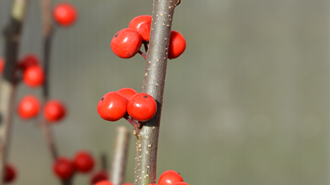Known for its distinct fruit, the winterberry holly is a medium-sized shrub native to the eastern half of the U.S.
Green leaves, delicately thin branches, and bursts of bright red berries sum up this shrub’s look. Sound familiar? Then there’s a chance you have a winterberry holly in your yard.
Keep reading to learn howto identify and care for winterberry holly shrubs.
Plant Identification by Leaf

Winterberry holly leaves are oval-shaped with a slight point at the top. Their color ranges from deep green to a lighter, yellow-green shade.
Plant Identification by Fruit

Perhaps the best way to identify a winterberry holly is by its fruit. Bright red berries appear in the fall. Winterberry holly loses its leaves late in the fall season, so in winter, the shrub has a signature look: shiny red berries hanging from bare, slender branches.

Plant Identification by Bark
Winterberry holly bark is light or dark gray with a smooth finish.
How to care for a Winterberry Holly
- Grow zones: Winterberry holly can grow in zones 3-9. The climate varies widely in this range, but generally, it's characterized by hot or humid summers and chilly winters.
- Where to plant winterberry holly: This shrub prefers acidic soil, but it can adapt to several different soil types.
- Height/Spread: The winterberry holly has a 5-10 ft height and spread.
- Sunlight: This shrub needs at least 4 and up to 6 hours of uninterrupted sunlight per day.
- Bloom time: Winterberry holly’s leaves and subtle white flowers bloom in late spring. In fall, the leaves fall off and bright red berries become the focal point.
- Pruning: Prune your plant in winter or early spring when it’s bare. Pruning winterberry holly is important for maintaining good health and keeping shape and size under control.
- Deer resistant: While winterberry holly isn’t a deer’s first choice, this plant is not completely deer resistant.
- Is winterberry holly poisonous to dogs?: Yes. Be sure to keep your pups away from this shrub. Winterberry holly berries are poisonous to us and our pets.
Potential Threats
Winterberry holly very rarely has pest or disease problems. If anything, powdery mildew or anthracnose could pose a threat. But in either case, these leaf problems are easy to manage. Learn more about treatment for fall tree fungus.





